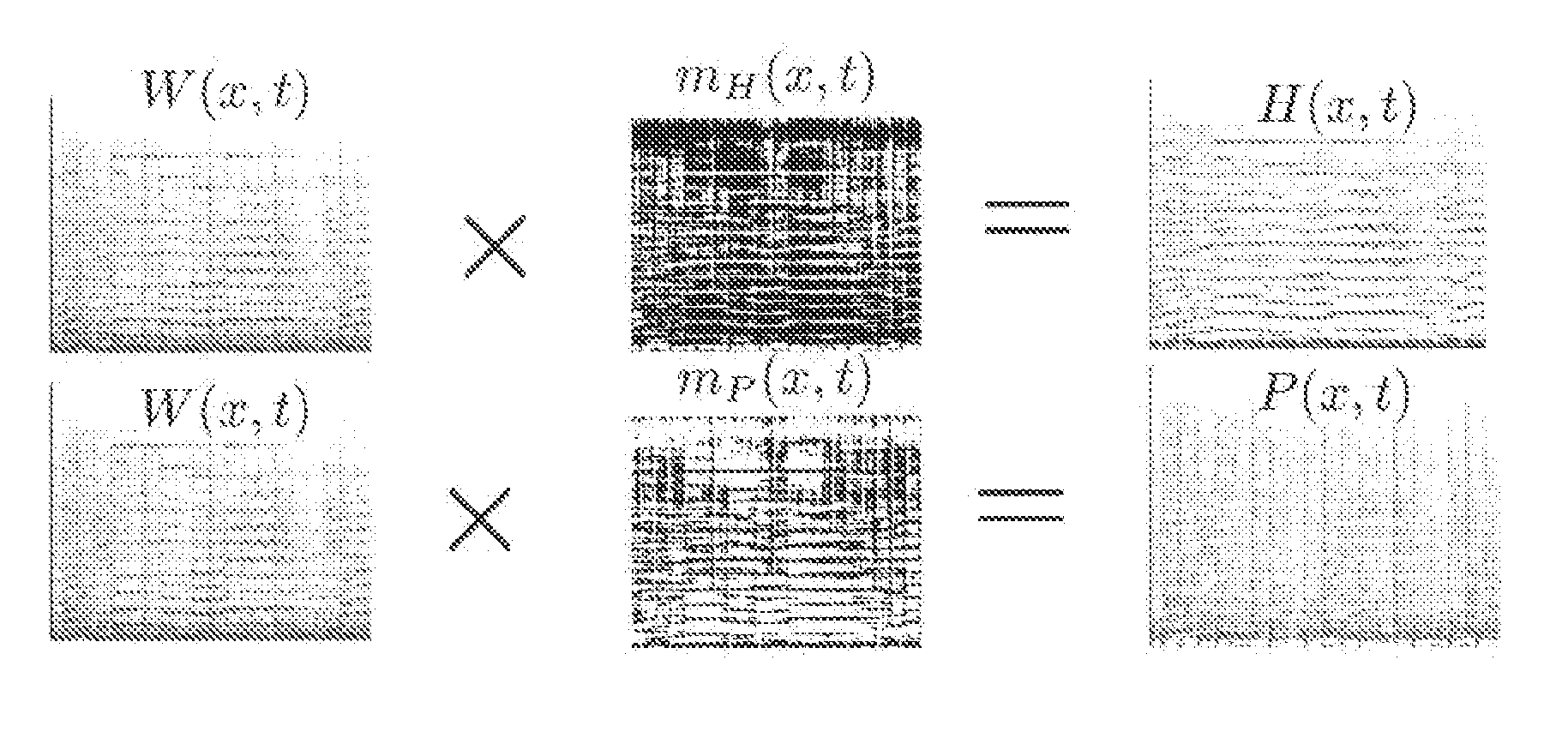Method of separating sound signal
a sound signal and acoustic technology, applied in the field of separating an acoustic (sound) signal, can solve the problems of difficult to analyze the music signal, difficult to separate harmonic/percussive components from a monaural acoustic signal, and still difficult to try to achieve the effect of separating the harmonic/percussive components
- Summary
- Abstract
- Description
- Claims
- Application Information
AI Technical Summary
Benefits of technology
Problems solved by technology
Method used
Image
Examples
first embodiment
[B] First Embodiment
[0078]According to the first embodiment, a spectrogram of an observed signal on time-frequency plane is assumed to be an image. Two-dimensional filters utilizing the difference in characteristics of harmonic sound and percussion sound are used to separate the percussion sound and the harmonic sound from the music signal without information particular to a music instrument.
[B-1] Mask Design by Using Outputs of Two-Dimensional Filters
[0079]Design of time-frequency masks mP(x, t) and mH(x, t) will be explained. Assuming that W(x, t) is an image, by applying two-dimensional filters for respectively extracting characteristics of P(x, t) and H(x, t), namely, edges along the frequency direction (vertical edges) and edges along the temporal direction (horizontal edges), it is possible to determine whether each time-frequency element belongs to P(x, t) or H(x, t) based on greater / smaller output results from filters.
[0080]Let two-dimensional Fourier-Transformed components ...
second embodiment
[C] Second Embodiment
[0092]As a separation method of music signal without utilizing information regarding scores and instruments, the first embodiment provides a fast computational method using the two dimensional filters on the spectrogram similar to those used in an image processing. According to the second embodiment, an iterative solution by an EM algorithm based on the anisotropy of smoothness of spectrogram is proposed and evaluation of computational time and performance is conducted. A real-time separation system using the algorithm of the second embodiment is also proposed.
[C-1] Introduction of Smoothness Cost
[0093]We discuss the solution to estimate H(x, t) and P(x, t) from W(x, t) using anisotropy of harmonic component and percussive component on the spectrogram. In the actual implementation, (x, t) can be obtained as discrete coordinates so that (x, t) is defined as a discrete time-frequency area (xi, tj) in the following discussion (i: frequency bin number, j: analyzing ...
third embodiment
[D] Third Embodiment
[0143]According to the second embodiment, H(x, t) and P(x, t) are estimated from W(x, t). According to the third embodiment, smoothness cost of distributed spectrogram is minimized without using H(x, t) and P(x, t).
[D-1] Prior Models of Harmonic / Percussive Components
[0144]Let Fh,i be a Short-Time Fourier Transform (STFT) of a monaural audio signal f(t), and Wh,i=φ(|Fh,i|2), where h and i represent indices of frequency and time bins. Wh,i is an usual spectrogram when φ(A)=A, and setting a convex function as φ(A) like φ(A)=Aγ (γ<1) yields a range compressed version of the spectrogram.
[0145]A harmonic component on the spectrogram usually has a stable pitch and form parallel ridges with smooth temporal envelopes, while the energy of a percussive tone is concentrated in a short time, which forms a vertical ridge with wideband spectral envelopes. Then typically, the vertical and horizontal structure emerges on the spectrogram of audio signals shown in FIG. 1. Since the...
PUM
 Login to View More
Login to View More Abstract
Description
Claims
Application Information
 Login to View More
Login to View More - R&D
- Intellectual Property
- Life Sciences
- Materials
- Tech Scout
- Unparalleled Data Quality
- Higher Quality Content
- 60% Fewer Hallucinations
Browse by: Latest US Patents, China's latest patents, Technical Efficacy Thesaurus, Application Domain, Technology Topic, Popular Technical Reports.
© 2025 PatSnap. All rights reserved.Legal|Privacy policy|Modern Slavery Act Transparency Statement|Sitemap|About US| Contact US: help@patsnap.com



